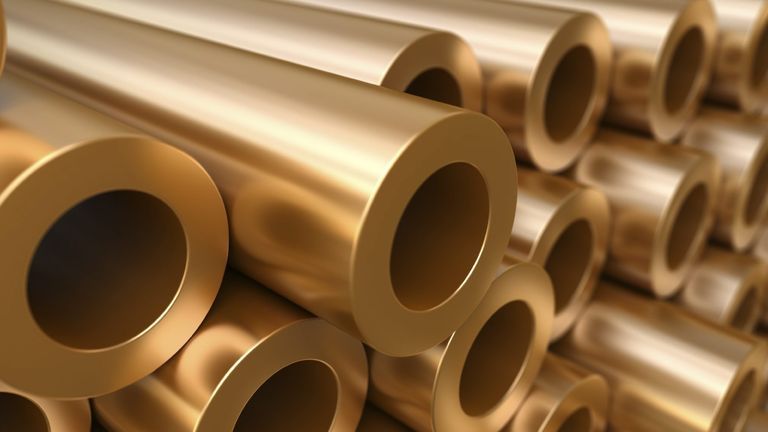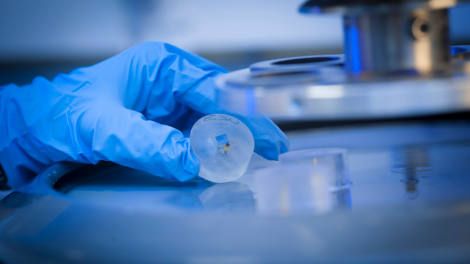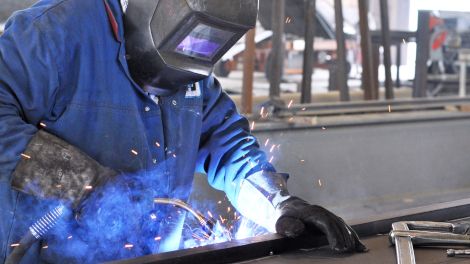NDT testing at TÜV NORD - Non-destructive materials testing
The aim of non-destructive testing (ndt) is to obtain as much information as possible about the condition of the material or a component without destroying it - i.e. without impairing its further usability. With the help of non-destructive testing methods, it is possible, for example, to obtain information about the wall thickness or the condition of weld seams and thus ensure safe continued operation without having to remove the relevant components. As a result, the operator saves cost-intensive replacement work and the procurement of replacement material.
For you as a manufacturer or operator of a technical system, non-destructive material testing (NDT) is an effective means of quickly obtaining a reliable statement about the quality of your product or the condition of your system in a cost-saving manner. This allows quality defects to be detected at an early stage. In addition, weak points as well as damages, often connected with unplanned downtimes and production losses, can be prevented and avoided. Our range of non-destructive testing services includes ultrasonic testing, dye penetrant testing, video endoscopy and many other methods.
Non-destructive testing methods: Our NDT services at a glance
Radiographic testing (RT)
Radiographic testing (RT) is an imaging method of non-destructive materials testing, particularly suitable for detecting defects in the component volume. Particularly voluminous and, if struck in the direction of irradiation, also planar defects in components can be detected. With the aid of a suitable emitter (X-ray tube, radioactive nuclide or accelerator), the density of a component is imaged on an X-ray film or digitally (imaging plate, detector, tomography). A projection image of the component appears with varying blackening due to different or deviating material thicknesses or densities, which may indicate defects in a component. Radiographic testing can be carried out both in our laboratories and on a mobile basis (taking radiation protection requirements into account). The testing techniques to be used (radiation source and recording arrangement) depend on the type and geometry as well as the defects to be found in the course of non-destructive component testing.
Magnetic particle inspection (MPI)
The magnetic particle testing (MPI) method or magnetic flux leakage method is a method for detecting defects in or near the surface of ferromagnetic materials. This method makes use of the change in magnetic flux leakage at defects in the area of surfaces. For the test, the surface to be tested must be magnetized. Defects near the surface that are transverse to the field lines generate a stray magnetic field. This means that the field lines exit the ferromagnetic material on one side of the defect and re-enter on the other side. If iron powder is now distributed over this stray field, it accumulates at the defect because it is attracted by the magnetic force field. Flaws that run parallel to the field lines do not generate a stray field and thus cannot be detected. Below the surface, they can be located to a certain depth. The MT method can be performed with iron powder and contrast dye and/or with magnetic powder fluorescing under UV light.
Visual inspection (VI)
The purpose of visual inspection is to detect and describe visually detectable defects or - generally speaking - deviations from specifications on an object. In order to be able to carry out this task correctly and conscientiously, a large number of basic requirements must be observed (e.g. surface condition, lighting) in order to perform an inspection task in accordance with the requirements. Depending on the inspection task and certain inspection features, a distinction is made between direct and indirect visual inspection (interrupted beam path) as well as local (targeted) and general visual inspection (overview inspection) - if necessary, this is done using certain aids such as mirrors, magnifying glasses, video endoscopes or even drones (e.g. for visual inspections at great heights). The inspection characteristics that are decisive for the type of visual inspection and the corresponding viewing conditions and assessment requirements include deviations in shape, geometry and position as well as irregularities due to manufacturing and operation.
Ultrasonic testing (VT)
Non-destructive materials testing by ultrasound (US testing) is a testing method with which components made of sound-conducting materials are tested with the help of ultrasonic waves. The frequencies used are in the range of 20 kHz and 1 to 10 GHz, i.e. above the frequency range perceived by the human ear. The test method is based on the time-of-flight measurement of sound waves that are emitted by an ultrasonic source and whose reflections are picked up by sound sensors. Defects such as cracks, inclusions, cavities, separation points or the occurrence of interfaces cause a deviation in the reflection behaviour of the sound waves. By evaluating the transit times, wall thicknesses, layer thicknesses and hardness depths can be measured and the type and position of defects that deviate from known nominal values can be detected. Only objects or defects whose size exceeds half the wavelength of the sound can be detected.
Eddy current testing (ET)
Eddy current testing (ET) is a non-destructive testing method for detecting defects such as cracks or imperfections in or near surfaces of metallic, electrically conductive materials. The basic principle is that alternating magnetic fields (primary fields) are generated on the surface of the test piece with the help of a coil charged with an alternating current. This induces eddy currents in the test piece. These eddy currents spread out in a ring and in turn generate alternating magnetic fields (secondary fields) which are oriented in the opposite direction to the primary fields. The secondary fields can be measured on the surface of the test piece and allow conclusions to be drawn about properties and condition. Since the technology and the associated sensors can be adapted to different testing tasks, there is a wide field of application for eddy current testing. At the Institute for Non-destructive Material Testing, we use the eddy current testing method e.g. for the non-destructive testing of weld seams and for drill holes in sugar centrifuges.
Penetrant testing (PT) - Dye penetrant testing
With the penetrant testing method (PT), surface defects in ferrous and non-ferrous metals, many plastics, ceramic materials, glass, etc. can be detected quickly and without great effort. The prerequisite for this test method is that the defects are open to the surface and the material is wettable. Forged parts, sheet metal, welded seams and castings, for example, are tested using the penetration method. This method is used in shipbuilding and aircraft construction, in the automotive industry, in apparatus and container construction and more. A penetrant is applied to the cleaned surface (spraying, dipping, brushing) and penetrates into imperfections. After intermediate cleaning, a developer is applied and "pulls" the color back out of the flaws. The coloration of the developer allows even small defects to be seen. The penetration method can be performed with penetrants that are visible in daylight and/or with penetrants that fluoresce under UV light. The characteristic feature of the penetrant method is that defects such as cracks, pores, etc. can be detected and made visible even on non-magnetizable materials.
Acoustic emission testing (AET)
Acoustic emission testing (AET) uses the physical effect that high-frequency sound waves (acoustic waves) are emitted when there are sudden changes in stress in the material. These are beyond the range of human hearing. AT sensors, which are attached to the component to be tested, detect these ultrasonic waves. In an acoustic emission measurement system, they are monitored and evaluated online in real time, allowing critical changes in the microstructure of the material to be detected at an early stage.
The mechanisms of acoustic emission include e.g.
- Crack bank friction
- Crack formation
- Crack propagation
- Turbulent flows at leakages
- Dislocation motion
- Phase transformation
- Corrosion processes
- Delamination.
In the context of industrial applications based on the recording and analysis of acoustic emission signals, our goal is to characterize the manufacturing quality or condition of your components and parts, to indicate fracture-critical damage situations before ultimate failure, and to locate areas of high acoustic emission activity or intensity. In addition, acoustic emission monitoring makes a major safety contribution during certain pressure and equipment tests. We therefore often use AT as an accompanying test method, e.g. for the acceptance and recurring tests of pressure vessels or for service life/ condition monitoring.
Thermography
The aim of infrared thermography is to use non-contact measurement of surface temperatures to determine structural properties, to assess physical aspects such as thermal bridges, and thus to assess the energy performance of building components.
This is suitable for example for:
- Apparatus
- Pipelines
- Electrical switchgear
- Buildings
- Inventory
- Condition analysis
- Renovation planning
- Verification of work done is possible.
Wherever there are temperature differences, problems can be sensibly described by thermographic tasks. This is because defects or imperfections often cause a disturbance of heat radiation and propagation. Our equipment is mainly used in the industrial sector to support maintenance tasks.
Fields of application are:
- Inspection of contact points in electrical switchgear both in the low-voltage and high-voltage range
- Inspection of the lining condition of reactors and industrial furnaces
- Determination of inadmissible deposits in exhaust chimneys and pipelines
- Control of the quality of insulations.
We would like to emphasize that our technology is capable of delivering reliable results in a wide range of atmospheric media or gases.
Videoscopy/Endoscopy
Endoscopy is one of the main methods of NDT materials testing. Many difficult-to-access apparatuses and pipelines can be inspected using what is now known as videoscopy. We have a wide range of techniques at our disposal for inspecting pipelines and containers: from container cameras with zoom lenses, to pipe cameras, to videoscopes or fibre optic endoscopes. State-of-the-art documentation technology enables the customer to retrace the inspections carried out afterwards. Typical fields of application are interior inspection for testing and condition monitoring from the inside as well as the localization of foreign bodies.
Quality promise from TÜV NORD
For non-destructive testing, our accredited testing laboratories with field-tested and certified testers with many years of know-how are at your disposal. We have access to a wide range of state-of-the-art testing equipment at our locations, such as UT phased array, ToFD and digital radiography.
- Testing laboratories according to DIN EN ISO/IEC 17025:2018
- Certified testers according to DIN EN ISO 9712, level 2 and 3 (additionally approved according to DGRL 2014/68/EU)
At your request, we provide non-destructive testing services for manufacturers and operators in Germany and abroad. In addition, we assess and evaluate non-destructive testing techniques and equipment, advise and assist in the preparation of specifications, testing instructions and concepts. We offer to take over the test supervision for non-destructive testing for manufacturers and operators. Furthermore, our company is recognized worldwide as a "Third Party Organization" - means for you:
- Cost reduction
- Quality improvement
- Existing network of specialists
- Reduction of administrative effort
Do you have questions about materials testing? We are at your disposal!
Please feel free to contact our locations directly.
Certification body for NDT personnel
TÜV NORD operates a certification body for non-destructive testing personnel (NDT personnel), which is accredited according to ISO/IEC 17024. Our certification body offers the possibility of having your company's NDT personnel certified according to DIN EN ISO 9712.
For personnel performing non-destructive testing on permanent connections of pressure equipment, the certification is considered an endorsement according to the European Pressure Equipment Directive 2014/68/EU. Our qualification tests, which are prerequisites for certification, are performed in both fixed and mobile testing centers.
Not what you are looking for?
Learn more about our destructive testing procedures or start at our materials testing home page.


